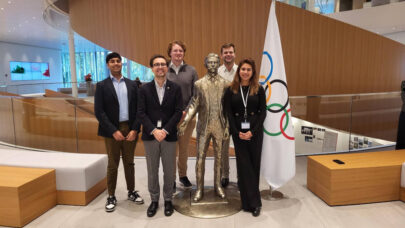For many people, when asked to name the biggest players in the tech space, it’s the so-called ‘big five’ – Apple, Alphabet, Microsoft, Facebook and Amazon – that immediately spring to mind.
But an explosion of digital ecosystems in China means the world’s second largest economy is increasingly becoming an unstoppable force, with homegrown tech giants gobbling up global market share.
“While the ‘big five’ have been part of the world’s life for a long time we are now increasingly seeing Chinese companies taking over,” said Mark Greeven, Professor of Innovation and Strategy, on day two of Orchestrating Winning Performance in Dubai.
Key ingredients
Take Chinese e-commerce giant Alibaba, for example. The company accounts for a reported 58% of all online retail sales in China. As of June 2019, the company had 755 million active users; more than twice the entire population of the United States.
Tencent, a multinational conglomerate internet-based platform, has experienced similarly impressive growth, and together the two companies – or digital ecosystems – have a joint valuation equivalent to the GDP of Switzerland.
The pace of growth is no less impressive – these ecosystems have emerged in less than 20 years and have been fuelled by investment and acquisition, entrepreneurship, new ventures, continuous innovation and internationalisation.
What is China’s secret ingredient?
The country’s recent success is down to several key factors, said Greeven, namely the business landscape, growing demand for digital and the attitude and ambition of investors.
China has protected internal business growth by blocking access to some of the ‘big five’, and others – such as Amazon and Apple – are retreating from the Chinese market due to market limitations and plummeting sales.
Attitude and ambition
The Chinese approach and attitude to business has also played a key role. Alibaba’s mission statement is to become the size of the world’s fifth-largest economy in the world – currently California.
This vision, in which they see themselves not as a company or a group but as an economy with no limitations, has played a major role in its success. And with a market cap of US$352 billion (as of December 2018) and with two million merchants on their books, this grand ambition may not be beyond the realm of possibility, said Greeven.
Alibaba began life as a B2B trading platform, and over time expanded to launch e-shared services such as advertisements, smart logistics, payment solutions and cloud sharing.
This model allowed buyers and sellers to connect within a self-contained organism; with layers of businesses and companies all connected to the core business product “like glue”, Greeven explained.
In September 2014, Alibaba launched the world’s biggest ever IPO. “They could have stopped there,” said Greeven. “But they knew China is dynamic and they knew times would change. While e-commerce might be successful today, it might not be in 10 years’ time.”
The IPO was followed by a period of aggressive investment in companies, all while making sure – through data-sharing and shared services – that these businesses remained linked to the core – or glue – of the company.
Rapid, responsive, resilient
China’s emergence as a dominant force in the global business landscape shows few signs of slowing, said Greeven. Over the next decade, 50% of new global consumption growth will take place in Asia and China.
What can companies in other parts of the world learn from China?
While the nascent technological space which the likes of Alibaba thrived on over a decade ago can never be replicated, there is much to be learned from the attitude, connectivity and flexibility of the Chinese business ecosystem, said Greeven.
Chinese businesses are rapid, responsive and resilient, and their organic growth and inclusivity has created an interdependence which serves one thing – further growth.



